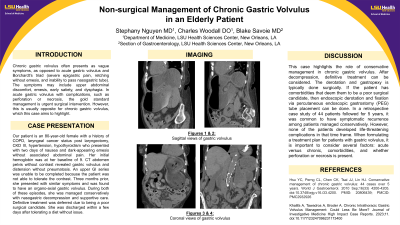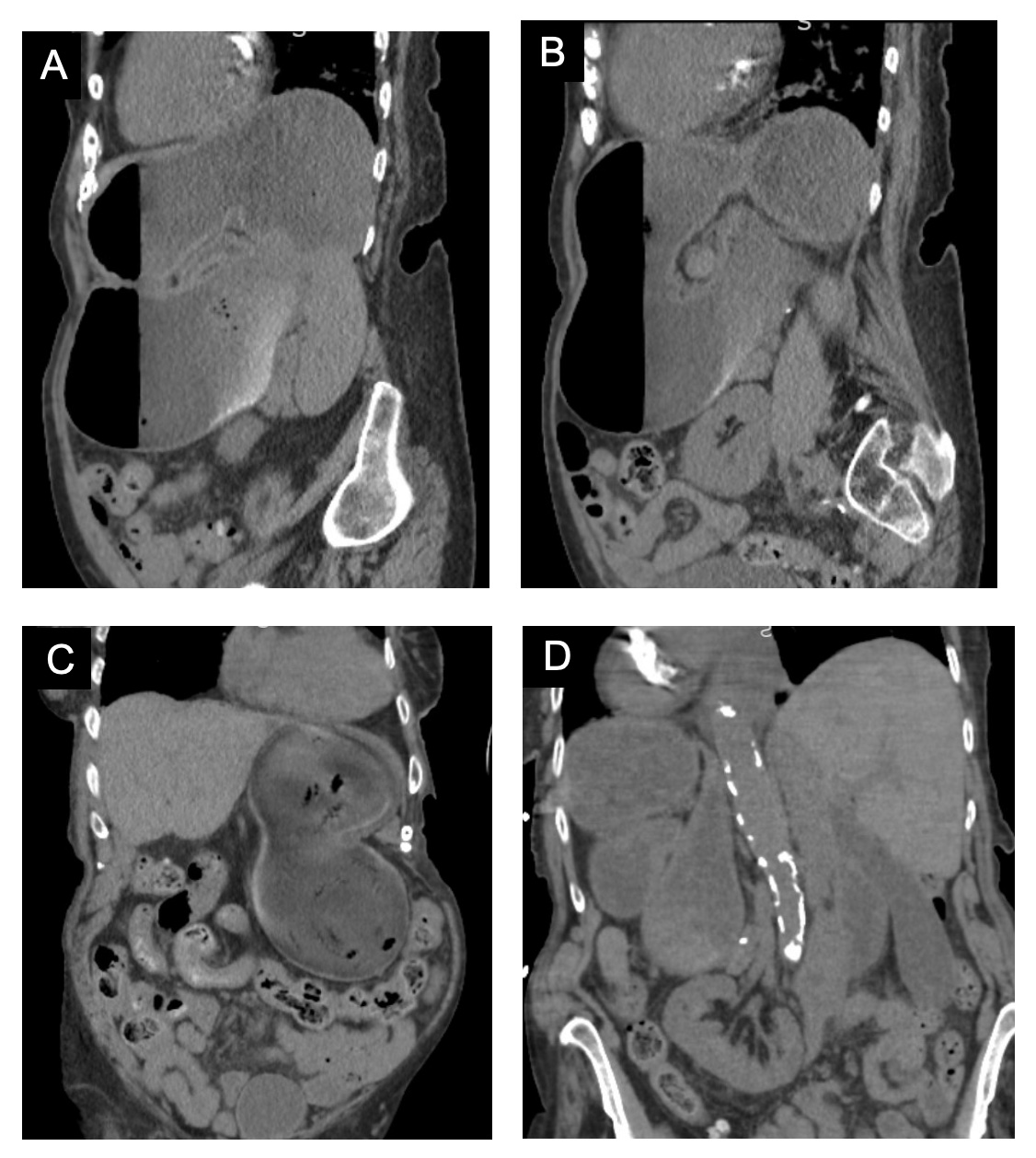Monday Poster Session
Category: Stomach
P3369 - Non-Surgical Management of Chronic Gastric Volvulus in an Elderly Patient
Monday, October 28, 2024
10:30 AM - 4:00 PM ET
Location: Exhibit Hall E

Has Audio
- SN
Stephany Nguyen, MD
LSU
New Orleans, LA
Presenting Author(s)
Stephany Nguyen, MD1, Charles B. Woodall, DO2, Blake Savoie, MD1
1LSU, New Orleans, LA; 2Louisiana State University Health Sciences Center, Covington, LA
Introduction: Chronic gastric volvulus often presents as vague symptoms, as opposed to acute gastric volvulus and Borchardt’s triad (severe epigastric pain, retching without emesis, and inability to pass nasogastric tube). The symptoms may include upper abdominal discomfort, emesis, early satiety, and dysphagia. In acute gastric volvulus with complications, such as perforation or necrosis, the gold standard management is urgent surgical intervention. However, this is usually opposite for chronic gastric volvulus, which this case aims to highlight.
Case Description/Methods: Our patient is an 80-year-old female with a history of COPD, laryngeal cancer status post laryngectomy, CKD III, hypertension, hypothyroidism who presented with two days of nausea and dark-appearing emesis without associated abdominal pain. Her initial hemoglobin was at her baseline of 9. CT abdomen pelvis without contrast revealed gastric volvulus and distension without pneumatosis. An upper GI series was unable to be completed because the patient was not able to tolerate the contrast. Three months prior, she presented with similar symptoms and was found to have an organo-axial gastric volvulus. During both of these episodes, she was managed conservatively with nasogastric decompression and supportive care. Definitive treatment was deferred due to being a poor surgical candidate. She was discharged within a few days after tolerating a diet without issue.
Discussion: This case highlights the role of conservative management in chronic gastric volvulus. After decompression, definitive treatment can be considered. The derotation and gastropexy is typically done surgically. If the patient has comorbidities that deem them to be a poor surgical candidate, then endoscopic derotation and fixation via percutaneous endoscopic gastrostomy (PEG) tube placement can be done. In a retrospective case study of 44 patients followed for 5 years, it was common to have symptomatic recurrence among patients managed conservatively. However, none of the patients developed life-threatening complications in that time frame. When formulating a treatment plan for patients with gastric volvulus, it is important to consider several factors: acute versus chronic, comorbidities, and whether perforation or necrosis is present.

Disclosures:
Stephany Nguyen, MD1, Charles B. Woodall, DO2, Blake Savoie, MD1. P3369 - Non-Surgical Management of Chronic Gastric Volvulus in an Elderly Patient, ACG 2024 Annual Scientific Meeting Abstracts. Philadelphia, PA: American College of Gastroenterology.
1LSU, New Orleans, LA; 2Louisiana State University Health Sciences Center, Covington, LA
Introduction: Chronic gastric volvulus often presents as vague symptoms, as opposed to acute gastric volvulus and Borchardt’s triad (severe epigastric pain, retching without emesis, and inability to pass nasogastric tube). The symptoms may include upper abdominal discomfort, emesis, early satiety, and dysphagia. In acute gastric volvulus with complications, such as perforation or necrosis, the gold standard management is urgent surgical intervention. However, this is usually opposite for chronic gastric volvulus, which this case aims to highlight.
Case Description/Methods: Our patient is an 80-year-old female with a history of COPD, laryngeal cancer status post laryngectomy, CKD III, hypertension, hypothyroidism who presented with two days of nausea and dark-appearing emesis without associated abdominal pain. Her initial hemoglobin was at her baseline of 9. CT abdomen pelvis without contrast revealed gastric volvulus and distension without pneumatosis. An upper GI series was unable to be completed because the patient was not able to tolerate the contrast. Three months prior, she presented with similar symptoms and was found to have an organo-axial gastric volvulus. During both of these episodes, she was managed conservatively with nasogastric decompression and supportive care. Definitive treatment was deferred due to being a poor surgical candidate. She was discharged within a few days after tolerating a diet without issue.
Discussion: This case highlights the role of conservative management in chronic gastric volvulus. After decompression, definitive treatment can be considered. The derotation and gastropexy is typically done surgically. If the patient has comorbidities that deem them to be a poor surgical candidate, then endoscopic derotation and fixation via percutaneous endoscopic gastrostomy (PEG) tube placement can be done. In a retrospective case study of 44 patients followed for 5 years, it was common to have symptomatic recurrence among patients managed conservatively. However, none of the patients developed life-threatening complications in that time frame. When formulating a treatment plan for patients with gastric volvulus, it is important to consider several factors: acute versus chronic, comorbidities, and whether perforation or necrosis is present.

Figure: Figures A & B: Sagittal views of gastric volvulus
Figures C & D: Coronal views of gastric volvulus
Figures C & D: Coronal views of gastric volvulus
Disclosures:
Stephany Nguyen indicated no relevant financial relationships.
Charles Woodall indicated no relevant financial relationships.
Blake Savoie indicated no relevant financial relationships.
Stephany Nguyen, MD1, Charles B. Woodall, DO2, Blake Savoie, MD1. P3369 - Non-Surgical Management of Chronic Gastric Volvulus in an Elderly Patient, ACG 2024 Annual Scientific Meeting Abstracts. Philadelphia, PA: American College of Gastroenterology.
